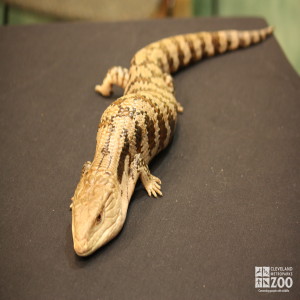New Guinea Blue-Tongued Skink
[Tiliqua gigas]

The New Guinea Blue Tongued Skink is up to 20 inches long, with a bulky body and short, strong legs. Coloration is basically golden to grayish-brown with darker brown crossbands continued onto the tail. The sides are covered with a broad, irregular blackish brown band that extends over the legs, and is occasionally interrupted by weak extensions of the golden-brown back color onto the sides. The belly is pale with many dusky spots at the edges of the scales. There may be a dark stripe behind the eye. Males are a bit heavier and duller-appearing than females, and with somewhat shorter tails. The eyes are reddish-brown to bright red, variable with the season and the mood. The head is large, conical and flattened. The tongue, as the name implies, is blue.
Location: Animals Formerly at Zoo
Share:
Range
The range of the New Guinea Blue Tongued Skink is Southern New Guinea through the Indonesian Islands to Sumatra.
Habitat
New Guinea Blue Tongued Skinks inhabit Scrubland.
Conservation Status
Primary Threats
Gestation
Gestation last 4 to 5 months.
Litter
2 to 23 eggs
Behavior
As thermophilous (heat-loving) animals,New Guinea Blue Tongued skinks are found predominantly in the tropical and sub-tropical regions of the earth. They are decidedly terrestrial, avoiding—with few exceptions—the immediate vicinity of bodies of water. Tiliqua gigas is a diurnal ground-dweller. They are territorial, and if two are kept together in captivity they can be very aggressive. When threatened they exhibit a characteristic defensive posture with the head raised slightly, the mouth open with the dark blue tongue displayed, and a simultaneous hiss.
Reproduction
The male New Guinea blue tongued skink will follow the female sometimes for several hours until he established a firm bite in the neck region, followed by copulation. It was once thought that most skinks were ovoviviparous, but more recent research has revealed that about two-thirds of the species lay eggs. The number of eggs in a clutch varies between 2 and 23. Some species care for their young. They reach maturity in a little over 2 years.
Wild Diet
Fruit, plants
Zoo Diet
Fruit, vegetables, meal worms, snails, meat, marmoset diet
